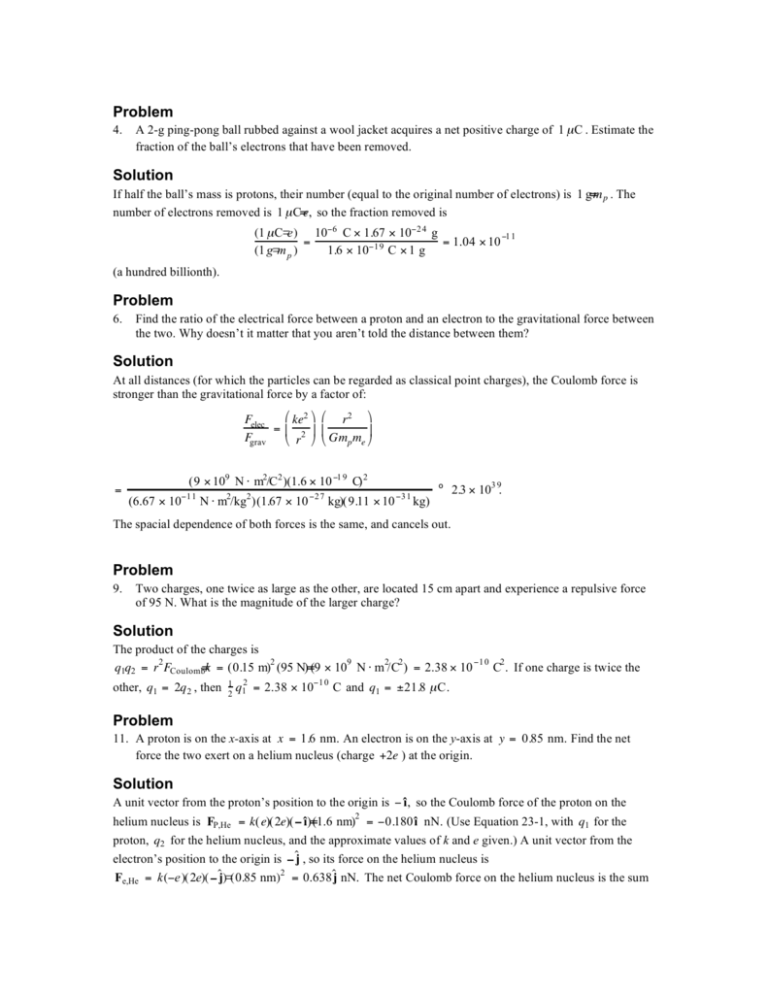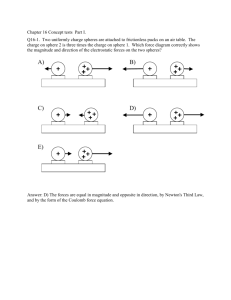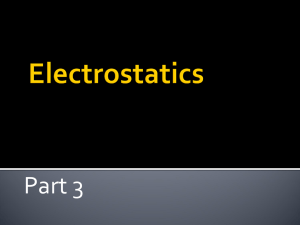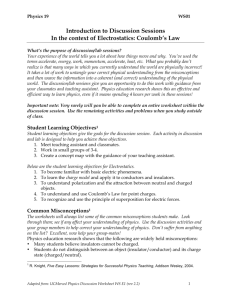Problem Solution Problem Solution Problem Solution Problem
advertisement

Problem 4. A 2-g ping-pong ball rubbed against a wool jacket acquires a net positive charge of 1 µ C . Estimate the fraction of the ball’s electrons that have been removed. Solution If half the ball’s mass is protons, their number (equal to the original number of electrons) is 1 g=m p . The number of electrons removed is 1 µ C=e, so the fraction removed is (1 µ C=e) 10!6 C " 1.67 " 10!2 4 g = = 1.04 " 10 !1 1 (1 g=m p ) 1.6 " 10!1 9 C " 1 g (a hundred billionth). Problem 6. Find the ratio of the electrical force between a proton and an electron to the gravitational force between the two. Why doesn’t it matter that you aren’t told the distance between them? Solution At all distances (for which the particles can be regarded as classical point charges), the Coulomb force is stronger than the gravitational force by a factor of: ! ke2 $ ! r2 $ Felec =# 2 & # & Fgrav " r % " Gmp me % = (9 ! 109 N " m2/C 2 )(1.6 ! 10 #1 9 C) 2 (6.67 ! 10#1 1 N " m2/kg2 )(1.67 ! 10 #2 7 kg)( 9.11 ! 10 #3 1 kg) º 2.3 ! 103 9. The spacial dependence of both forces is the same, and cancels out. Problem 9. Two charges, one twice as large as the other, are located 15 cm apart and experience a repulsive force of 95 N. What is the magnitude of the larger charge? Solution The product of the charges is q1q2 = r2 FCoulomb=k = (0.15 m)2 (95 N)=(9 ! 109 N " m2/C2 ) = 2.38 ! 10 #1 0 C2 . If one charge is twice the other, q1 = 2q 2 , then 1 2 q12 = 2.38 ! 10"1 0 C and q1 = ±21.8 µ C. Problem 11. A proton is on the x-axis at x = 1.6 nm. An electron is on the y-axis at y = 0.85 nm. Find the net force the two exert on a helium nucleus (charge +2e ) at the origin. Solution A unit vector from the proton’s position to the origin is ! î, so the Coulomb force of the proton on the 2 helium nucleus is FP,He = k( e)(2e)(! î)=(1.6 nm) = !0.180î nN. (Use Equation 23-1, with q1 for the proton, q2 for the helium nucleus, and the approximate values of k and e given.) A unit vector from the electron’s position to the origin is ! ˆj , so its force on the helium nucleus is Fe,He = k(!e)(2e)(! ˆj)=(0.85 nm)2 = 0.638ˆj nN. The net Coulomb force on the helium nucleus is the sum of these. (The vector form of Coulomb’s law and superposition, as explained in the solution to Problems 15 and 19, provides a more general approach.) Problem 14. A proton is at the origin and an electron is at the point x = 0.41 nm, y = 0.36 nm. Find the electric force on the proton. Solution The magnitude of the force is Fp = ke2 r = 2 (9 ! 109 N " m2 /C 2 )(1.6 ! 10 #1 9 C)2 2 2 #1 8 (0.41 + 0.36 ) ! 10 2 m = 7.74 ! 10#1 0 N, and its direction is from the proton (at rp = 0) to the electron (at re = (0.41î + 0.36 ˆj) nm), for an "1 attractive force, at an angle ! = tan (0.36=0.41) = 41.3° to the x-axis. The vector form of Coulomb’s law, 3 Fp = !ke2 (rp ! re )=r p ! re (see solution of next problem) gives the same result: F p = !(9 " 109 N # m2/C 2 )(1.6 " 10 !1 9 C) 2 (!0.41î ! 0.36ˆj)=(0.412 + 0.362 )3=2 (10!9 m)2 = (5.82î + 5.11ˆj) " 10!1 0 N. Problem 16. A charge 3q is at the origin, and a charge !2q is on the positive x-axis at x = a. Where would you place a third charge so it would experience no net electric force? Solution The reasoning of Example 23-3 implies that for the force on a third charge Q to be zero, it must be placed on the x-axis to the right of the (smaller) negative charge, i.e., at x > a. The net Coulomb force on a third charge !2 !2 2 2 so placed is Fx = kQ[3qx ! 2q(x ! a) ], so Fx = 0 implies that 3(x ! a) = 2x , or x 2 ! 6xa + 3a 2 = 0. Thus, x = 3a ± 9a 2 ! 3a 2 = (3 ± 6)a. Only the solution (3 + 6)a = 5.45a is to the right of x = a. Problem 19. In Fig. 23-39 take q1 = 68 µ C, q2 = !34 µ C, and q3 = 15 µC. Find the electric force on q3. Solution Denote the positions of the charges by r1 = jˆ, r2 = 2î, and r3 = 2î + 2ˆj (distances in meters). The vector form of Coulomb’s law (in the solution to Problem 15) and the superposition principle give the net electric force on q3 as: F3 = F1 3 + F2 3 = kq1 q3 (r3 ! r1 ) r3 ! r1 3 + kq2 q3 (r3 ! r2 ) r3 ! r2 3 = (9 " 109 N)(15 " 10 !6 )[( 68 " 10!6 )(2î + ˆj)=5 5 + (!34 " 10 !6 )2ˆj=8] = (1.64î ! 0.326ˆj) N, or F3 = 2 F23x + F3y = 1.67 N at an angle of ! = tan (F3y=F3x ) = "11.2° to the x-axis. "1 FIGURE 23-39 Problem 19 Solution. Problem 21. Four identical charges q form a square of side a. Find the magnitude of the electric force on any of the charges. Solution By symmetry, the magnitude of the force on any charge is the same. Let’s find this for the charge at the lower left corner, which we take as the origin, as shown. Then r1 = 0, r2 = aˆj, r3 = a(î + ˆj), r4 = aî, and " r !r ˆ a(î + ˆj) aî % r1 ! r3 r1 ! r4 % kq 2 2 " !a j 2 ˆ (1 + 1 +- , ' F1 = kq2 $ 1 3 + 3 + 3 = kq $ 3 ! 3 ! 3 ' = ! 2 (î + j)* ) a 2 2a a a 2 2, $# r1 ! r2 $# '& r1 ! r3 r1 ! r4 '& (Use the vector form of Coulomb’s law in the solution to Problem 15, and the superposition principle.) 2 2 2 2 2 2 Since î + ˆj = 2 , F1 = (kq =a ) 2(1 + 1=2 2 ) = (kq =a )( 2 + 1 ) = 1.91kq =a . 2 Problem 21 Solution. Problem 22. Three identical charges +q and a fourth charge !q form a square of side a. (a) Find the magnitude of the electric force on a charge Q placed at the center of the square. (b) Describe the direction of this force. Solution 2 2 The magnitudes of the forces on Q from each of the four charges are equal to kqQ= ( 2a=2) = 2kqQ=a . But the forces from the two positive charges on the same diagonal are in opposite directions, and cancel, while the forces from the positive and negative charges on the other diagonal are in the same direction (depending 2 on the sign of Q) and add. Thus, the net force on Q has magnitude 2(2kqQ=a ) and is directed toward (or away from) the negative charge for Q > 0 (or Q < 0). Problem 24. Two identical small metal spheres initially carry charges q1 and q2, respectively. When they’re 1.0 m apart they experience a 2.5-N attractive force. Then they’re brought together so charge moves from one to the other until they have the same net charge. They’re again placed 1.0 m apart, and now they repel with a 2.5-N force. What were the original values of q1 and q 2? Solution 2 The charges initially attract, so q1 and q2 have opposite signs, and 2.5 N = !kq1q2=1 m . When the spheres are brought together, they share the total charge equally, each acquiring 2 1 2 (q1 + q2 ). The magnitude of their 2 repulsion is 2.5 N = k 14 (q1 + q2 ) =1 m . Equating these two forces, we find a quadratic equation 1 4 (q1 + q2 )2 = !q1q2 , or q12 + 6q1q2 + q22 = 0, with solutions q1 = (!3 ± 8)q2 . Both solutions are !1 possible, but since 3 + 8 = (3 ! 8) , they merely represent a relabeling of the charges. Since 2 9 2 2 2 !q1q2 = 2.5 N " m =(9 # 10 N " m /C ) = (16.7 µ C) , the solutions are q1 = ± 3 + 8 (16.7 µ C) = ±40.2 µ C and q2 = m40.2 µ C=(3 + 8) = m6.90 µC, or the same values with q1 and q2 interchanged. Problem 30. A 65- µC point charge is at the origin. Find the electric field at the points (a) x = 50 cm, y = 0; (b) x = 50 cm, y = 50 cm; (c) x = !25 cm, y = 75 cm. Solution 2 3 The electric field from a point charge at the origin is E(r) = kqrˆ=r = kqr=r , since rˆ = r=r. (a) For r = 0.5î m 9 2 2 2 and q = 65 µ C, E = (9 ! 10 N " m /C )(65 µ C)î=(0.5 m) = 2.34î MN/C. (b) At r = 0.5 m (î + ˆj), E = (9 ! 65 ! 103 N " m 2/C)(0.5 m)( î + ˆj)=(0.5 2 m) 3 = (827 kN/C)(î + ˆj). (The field strength is 1.17 MN/C at 45° to the x axis.) (c) When r = (!0.25î + 0.75ˆj) m, E = (5.85 " 10 5 N # m 2/C)(!0.25î + 0.75ˆj) m=[(!0.25) 2 + (0.75)2 ]3=2 m3 = (!296 î + 888ˆj) kN/C ( E = 936 kN/C, " = 108°). x Problem 32. A 1.0- µC charge and a 2.0- µC charge are 10 cm apart, as shown in Fig. 23-41. Find a point where the electric field is zero. FIGURE 23-41 Problem 32 Solution. Solution The field can be zero only along the line joining the charges (the x-axis). To the left or right of both charges, the fields due to each are in the same direction, and cannot add to zero. Between the two, a 2 2 distance x > 0 from the 1 µ C charge, the electric field is E = k[q1 î=x + q2 (! î)=(10 cm ! x) ], which 2 2 vanishes when 1 µ C=x = 2 µ C=(10 cm ! x) , or x = 10 cm=( 2 + 1) = 4.14 cm. Problem 37. A dipole lies on the y axis, and consists of an electron at y = 0.60 nm and a proton at y = !0.60 nm. Find the electric field (a) midway between the two charges, (b) at the point x = 2.0 nm, y = 0, and (c) at the point x = !20 nm, y = 0. Solution We can use the result of Example 23-6, with y replaced by x, and x by ! y (or equivalently, ˆj by î , and î by ! ˆj) . Then E(x) = 2kqa ˆj(a 2 + x 2 ) !3=2 , where q = e = 1.6 ! 10"1 9 C and a = 0.6 nm. (Look at Fig. 23-18 rotated 90° CW.) The constant 2 2kq = 2(9 ! 109 N " m2/C2 )(1.6 ! 10#1 9 C) = (2.88 GN/C)(nm) 2 . (a) At x = 0, E(0) = 2kqˆj=a = 2 (2.88 GN/C)ˆj=(0.6) = (8.00 GN/C)ˆj. (b) For x = 2 nm, 2 2 !3=2 E = (2.88 GN/C)ˆj(0.6)(0.6 + 2 ) = (190 MN/C) ˆj. 2 2 !3=2 ˆ = (216 kN/C) ˆj . (c) At x = 20 nm, E = (2.88 GN/C) j(0.6)(0.6 + 20 ) Problem "3 0 39. The dipole moment of the water molecule is 6.2 ! 10 C# m. What would be the separation distance if the molecule consisted of charges ±e ? (The effective charge is actually less because electrons are shared by the oxygen and hydrogen atoms.) Solution The distance separating the charges of a dipole is d = p=q = 6.2 ! 10 "3 0 C # m=1.6 ! 10"1 9 C = 38.8 pm. Problem 40. You’re 1.5 m from a charge distribution whose size is much less than 1 m. You measure an electric field strength of 282 N/C. You move to a distance of 2.0 m and the field strength becomes 119 N/C. What is the net charge of the distribution? Hint: Don’t try to calculate the charge. Determine instead how the field decreases with distance, and from that infer the charge. Solution n Taking the hint, we suppose that the field strength varies with a power of the distance, E ' r . Then 282=119 = (1.5=2) n , or n = ln(282=119)=ln(0.75) = !3.00. A dipole field falls off like r !3, hence the net charge is zero. Problem 43. A 30-cm-long rod carries a charge of 80 µC spread uniformly over its length. Find the electric field strength on the rod axis, 45 cm from the end of the rod. Solution Applying the result of Example 23-7, at a distance a = 0.45 m from the near end of the rod, we get 9 2 2 E = kQ=a(a + l) = (9 ! 10 N " m /C )(80 µ C)=(0.45 m)(0.45 m + 0.30 m) = 2.13 MN/C. Problem 46. Two identical rods of length l lie on the x-axis and carry uniform charges ±Q, as shown in Fig. 23-43. (a) Find an expression for the electric field strength as a function of position x for points to the right of 3 the right-hand rod. (b) Show that your result has the 1=x dependence of a dipole field for x ¿ l . (c) What is the dipole moment of this configuration? Hint: See Equation 23-7b. FIGURE 23-43 Problem 46 Solution. Solution (a) The field due to each rod, for a point on their common axis, can be obtained from Example 23-7: E+ = kQ=x( x ! l), to the right, and E! = kq=x( x + l), to the left. The resultant field (positive right) is E = E+ ! E ! = kQ " 1 1 % 2kQl ! = . $ ' x # x ! l x + l& x( x 2 ! l2 ) 3 (b) For x ¿ l, E º 2 kQl=x . (c) Comparison with Equation 23-7b shows that the rods appear like a dipole with moment p = Ql. Problem 48. Figure 23-44 shows a thin, uniformly charged disk of radius R. Imagine the disk divided into rings of varying radii r, as suggested in the figure. (a) Show that the area of such a ring is very nearly 2! r dr . 2 (b) If the surface charge density on the disk is ! C/m , use the result of (a) to write an expression for the charge dq on an infinitesimal ring. (c) Use the result of (b) along with the result of Example 23-8 to write the infinitesimal electric field dE of this ring at a point on the disk axis, taken to be the positive x axis. (d) Integrate over all such rings (that is, from r = 0 to r = R ), to show that the net electric field on the disk axis is $ E = 2 ! k " &1 # % FIGURE ' ). x 2 + R2 ( x 23-44 Problem 48. Solution 2 2 (a) The area of an anulus of radii R1 < R2 is just !( R2 " R1 ). For a thin ring, R1 = r and R2 = r + dr , 2 2 2 so the area is ![(r + dr ) " r ] = ! (2r dr + dr ). When dr is very small, the square term is negligible, and dA = 2! r dr . (This is equal to the circumference of the ring times its thickness.) (b) For surface charge density ! , dq = ! dA = 2"! r dr . (c) From Example 23-8, dE x = k( dq )x( x 2 + r2 ) !3=2 = 2" k# xr(x 2 + r2 ) !3=2 dr , which holds for x positive away from the ring’s R center. (d) Integrating from r = 0 to R, one finds Ex = ! 0 dE x , or Ex = 2! k" x # R 0 R r dr 2 3=2 (x 2 + r ) = 2! k" x $1 x 2 + r2 0 2 % x ( x *. = 2! k" ' $ 2 1 = 2 2 ' x * (x + R ) & ) 2 #1=2 (Note: For x > 0, x = x and the field is Ex = 2! k" [1 # x(x + R ) 2 2 #1=2 x < 0, x = !x and Ex = 2! k" [#1 + x (x + R ) ]. However, for ] . This is consistent with symmetry on the axis, since Ex ( x) = ! Ex (! x). ) Problem 50. A semicircular loop of radius a carries positive charge Q distributed uniformly over its length. Find the electric field at the center of the loop (point P in Fig. 23-45). Hint: Divide the loop into charge elements dq as shown in Fig. 23-45, and write dq in terms of the angle d! . Then integrate over ! to get the net field at P. FIGURE 23-45 Problem 50 Solution. Solution 2 This problem is the same as Problem 73, with !0 = 0. Thus, E(P) = 2kQî=! a . Problem 51. The electric field 22 cm from a long wire carrying a uniform line charge density is 1.9 kN/C. What will be the field strength 38 cm from the wire? Solution For a very long wire (l ¿ 38 cm) , Example 23-9 shows that the magnitude of the radial electric field falls off like 1=r. Therefore, E(38 cm)=E(22 cm) = 22 cm=38 cm; or E(38 cm) = (22=38)1.9 kN/C = 1.10 kN/C.








